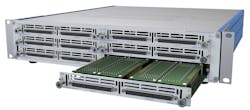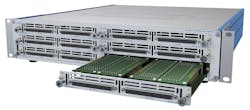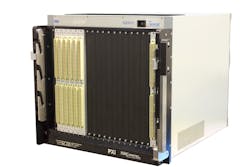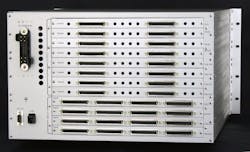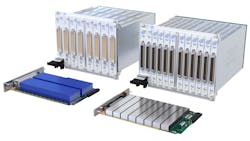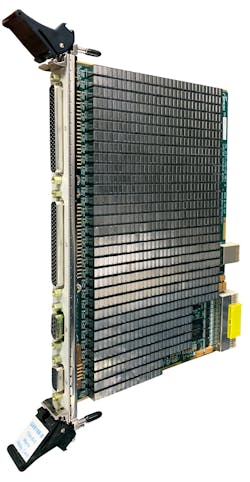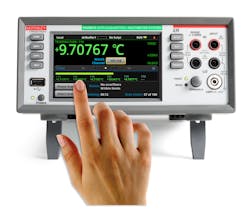Special Report: Switching vendors challenged to meet bandwidth demands
Download this article in .PDF format.
With the rise of smart cities, intelligent factories and the Internet of Things, manufacturers of switching systems are under increasing pressure to adapt their instruments for applications based around connectivity. Switching is a key part of any automated test system, and the technology innovation extends from systems and subsystems down to the component level of chips and relays.
Bob Stasonis, technical product specialist of Pickering Interfaces and president of the PXI Systems Alliance, touched on several other key factors impacting high-density switching systems.
“The proliferation of complex electronic control units (ECUs) across all electronic industries—especially automotive, aerospace, and semiconductor manufacturing—coupled with increasing time-to-market pressures, has made the automated functional verification of these ECUs using real-time hardware-in-the-loop (HIL) systems increasingly important. A key component of most HIL systems is automated fault simulation, and Pickering Interfaces is seeing a growing requirement for high-density fault insertion switching to address high IO count ECUs, especially in the automotive and aerospace industries.”
“Pickering has always been pushed to the limit of switching density by its customers,” Stasonis continued. “New trends in high-density switching include increased bandwidth, and, in several markets, especially in the semiconductor industry, we are being driven to improve isolation resistance. Currently, our average isolation resistance specification is greater than 109 Ω. Some of our BRIC high-density matrices have measured greater than 1011 Ω.”
Trending
We at Evaluation Engineering asked a number of leading electronic test & measurement instrument vendors about what they’re seeing as recent trends in high-density switching systems, or are expecting to see in the next 1-2 years. Here’s what they told us or said in recent press releases:
Grant Gothing, chief technology officer at Bloomy: “HIL testing for large aerospace and automotive applications allows OEMs and aerospace manufacturers to more rapidly develop and validate new hardware and software designs in scenarios where the unit under test thinks it is in the real world. A large part of HIL testing is real-sim switching and fault injection. Real-sim switching means that each IO point must be able to physically switch between a simulated model-driven signal and a real component (actuator, sensor, controller, etc). Fault injection switching entails injecting various faults (open connections (line break), short across pins, reverse polarity, short to ground, short to rails, short to adjacent signals) to ensure that the unit under test reacts appropriately. The result of these requirements is a massive amount of switching. Each simple 2-wire analog signal may require 6-12 relays to be able to inject all permutations of faults and real-sim connections. Increasing switch density and scalability is critical to developing large-scale automotive and aerospace HIL test systems.”
Nick Turner, CEO of Cytec: “In general we have not had a lot of recent requests in this area. While many customers would like the equipment to be as small as possible, their biggest concern is always performance and price, and size tends to be a little lower on the priority list. The three areas we have seen this as an issue is in large group switches where people are wanting to switch a large number of wires as a group, i.e.—a 1x16 switch that switches 250 wires at once, high-density communication matrices where the end-user may want to cross-connect hundreds of inputs with hundreds of outputs, and high current switches. The solid-state technology to do all of these in a smaller size is becoming increasingly common and less expensive.”
Josh Brown, application engineer at Tektronix: “With respect to trends in switching and data acquisition, we see a lot of the same basic measurement needs of voltage, temperature, and resistance—which lay the foundation for a number of other insights. More powerful ASIC devices enable instrument firmware engineers to build in enhanced features, such as more detailed and insightful displays of data on a given instrument’s user interface. As the need for higher volume applications increases, customers are focused on solutions that offer greater switch channel counts and faster switching speeds.”
Vijay Kulkarni, CEO of GL Communications: “With the explosion of interconnected devices and the coming Internet of Things, the demand for higher-density switching devices has been increasing. Vendors are coming out with switches with ever increasing number of gigabit Ethernet ports. Ethernet switches with 12 or 24 gigabit ports are getting common. Another trend is the demand for higher data capacity pipes. 10 gigabit Ethernet links are becoming common, as more users switch to 10G from 1G. High-density gigabit Ethernet switches now typically have 2 or 4 10G ports. Also, high-density “All 10G” switches with 4/8/16/24 10G ports are also being deployed as end users switch to “All 10G” environment in their premises.”
Norton Alderson, VP of marketing at Universal Switching Corporation: "We’ve seen a constant push of nearly all switching technical boundaries. Some are led by client needs and requirements, while others are by newly introduced technology. This includes higher switching density capabilities, as well as critical performance specifications such as higher frequency range, higher isolation, and low thermal needs, including smarter control capabilities."
Trade-offs
In order to support higher density, vendors often have to make sacrifices in other switching areas, such as lower limits on signal amplitude or frequency.
He added that a higher density in a form factor such as PXI will exhibit better bandwidth since the PCB traces are shorter, but the downside is that components in closer proximity to each other can increase the possibility of crosstalk. Also, in very high-density designs, PCB tracks will generally be closer to one another, so isolation resistance is also lower. The relays chosen can also affect isolation resistance.
“High switching densities can also result in lower hot and cold switch voltages, mainly because, as stated earlier, higher voltages in a very dense configuration can exhibit increased crosstalk because of the proximity of other devices,” Stasonis said. “So, manufacturers lower the hot and cold specifications to better manage this crosstalk.”
Stasonis went on to elaborate on the overall concept of trade-offs in high-density switching systems and how his company aims to provide customer-specific switching solutions instead of having to make trade-offs that could occur with offering only one platform option.
“Basically, the notion that larger board space, i.e, VXI, automatically brings along better performance than PXI, is incorrect,” Stasonis said. “Each design has its tradeoffs. The application and the specifications needed should dictate whether a high density or lower density design is needed. This is one of the reasons that Pickering has so many choices; We are a switching solution company not bound to any specific architecture. We try to fit the correct platform to the customer’s needs rather than making the customer shoehorn a specific platform into their system design. If an application requires higher densities and/or higher power and/or voltage than can be reasonably accommodated on a PXI module, we are able to offer larger form factor solutions in our LXI family of products.”
Here's what other vendors had to say on the topic of trade-offs:
“When integrating a new switch option (card or module) into an existing mainframe, designers will want to consider how best to optimize PCB space with respect to smaller switching devices, the trace carry/switching currents, and the power consumption and heat dissipation of any/all components involved.”
Jon Semancik, director of marketing at Ametek Programmable Power: “Solid-state switches offer advantages such as switching speed and longevity, but other key operational parameters such as bandwidth and leakage current continue to restrict their use in certain high-performance applications.”
Alderson, Universal Switching Corporation: "There are always tradeoffs for density. Unless the density is extreme, the tradeoff is typically not with performance, but in higher costs to achieve like performance of a less dense solution. The additional costs are derived from the use of higher performance components, additional shielding, high-performance PCB materials, and other packaging enhancements."
Other factors
While the size of a test system’s footprint is important, so too are its flexibility, reliability, and cost. Here’s what vendors had to say about what derating advice their company offers, and their thoughts on performance advantages that are associated with larger form factors or higher density technologies.
Stasonis, Pickering: “For defense and other hi-reliability applications that are required to function for a long life, it is advisable to derate. How much is dependent on the application—for example, will the unit be subject to high power and/or voltage spikes. Pickering Interfaces can advise on suitable products given the operational environment and conditions the equipment must function in are provided.
“Performance advantages depend on the application, but in general a higher-density switching system features shorter signal paths for better signal integrity and lower capacitance in the signal paths. However, on the downside, high-density switching products are likely to result in lower isolation resistance specs. The switching modules used will also affect performance. For example, if a high-density matrix is created by cabling together multiple modules, the cabling can affect overall performance because of the added length of the signal path and added capacitance of the cabling used. The use of a switch module like the Pickering BRIC, which features internal busses to interconnect switch modules in a unique form/factor, will provide better analog performance. Intelligent isolation relays on the Y axis minimizes stub lengths, which can help signal integrity at high frequencies.”
- Connector density and configuration. If someone wants a 256x1 multiplexer, it only requires 256 switches, but still requires 257 connectors which demand panel space. If they want something other than a high-density connector, it doesn’t matter how small the relays get. They still may need the rack height for that number of BNC or screw terminal connectors. On the other hand, if they want a 64x64 matrix, they need 4096 switches, but only 128 connectors, so having very small relays or a high-density switch fabric can save a ton of real estate.
- Voltage and current levels. Solid-state relays have done a lot to reduce the size of switching systems for low voltage, low current applications. We have a 256x256 Digital TTL matrix that packs 65,536 switches into an FPGA that is about 1” square. But solid-state relays tend to be very application-specific compared to larger mechanical relay,s which can typically handle hundreds of volts and a couple of amps of current in the same package. The solid-state relays that will hot switch a lot of current may not handle any high voltage. And some that do well with higher levels of voltage can have higher resistance. High voltage can specifically negate the advantages of solid-state relays because you still end up needing large physical separation between component or connectors to deal with the voltage levels.
- Frequency considerations—small solid-state RF relays have carved out another niche in the RF world because they may switch very fast and work well at high frequencies, but they often won’t handle DC or any large amount of power. So once again, they tend to be application-specific. And once you get into any high frequency you again are constrained by connector choices. While the newest miniature coax connectors may be fine for your cell phone antenna, they can be delicate and problematic to work with in rack-mount test equipment where people are used to BNC, F, and SMA connectors.
Brown, Tektronix: “With respect to derating, the user should pay particular attention to the specification details surrounding scan rates. While the core multimeter specifications tend to focus on optimal default system settings to provide insight on the highest quality readings possible, switching can impact quality. We do our best to make certain the customer understands that there may be trade-offs when scan/switching rates are higher. To achieve greater speed, we can disable measurement auto delays and auto zeroing, or decrease the measurement aperture time. This will help expedite data acquisition but increase the potential for signal noise not being removed from the reading. The key to success in this space is flexibility and reducing per-channel costs.”
Semancik, Ametek: “The physical space available for switching solutions is directly impacted by the interface used. PXIe, for example, has only limited area for the actual switching portion of the card since space must be available for the digital interface and controls. LXI, on the other hand, provides significantly more space based on the manufacturer's design criteria. Parameters such as cross-talk and signal isolation are directly impacted by reduced space typical in PC-based architectures such as PXIe. Reduced spacing between traces and other design features such as ground plane placement will definitely impact bandwidth and noise.”
Gothing, Bloomy: “Bloomy’s HIL Simulation System solutions are based on a modular architecture, using chasses full of instrumentation and switching cards. By using this modular architecture, Bloomy’s HIL Simulation platform can scale up or down to meet customer needs. Furthermore, switching architectures can be adjusted to meet requirements by mixing and matching cards with varying topologies.”
Kulkarni, GL Communications: “Testing of such high-density 1G/10G switches requires a corresponding high-density test equipment, with a high density of ports. To properly test such high-density switches, the test equipment must be capable of generating and handling traffic at full 1 Gbps or 10 Gbps on all its 1G/10G ports, simultaneously. That means, to test a 12- or 24-port Gigabit ethernet switch, the test equipment must be capable of generating Gbps rate on all 12/24 ports, and simultaneously capable of handling the traffic returned from the switch, and analyze for errors, totaling to a capacity of 24 Gbps or 48 Gbps. Similarly, to test a switch with 3/6 10G ports, requires a traffic capacity of 60/120 Gbps in total.”
Alderson, Universal Switching Corporation: "Universal Switching products are all LXI-certified due to our unit modular designs, which include our C3 or C3-Lite controllers. These controllers will be adding 1 gigabit capability this year to augment the current 10/100 capability. All our products include web browser, microSD slot (for local removable memory in secure environments), LXI certification, SNMP (v1/2/3), SNTP, IPv4/6."
Now on the market
The capabilities of solid-state switches and subminiature relays continue to increase, which allows for ever-more dense switching assemblies. For switching instrument vendors, this requires making constant technical improvements and leveraging them to develop new dense switching solutions.
Here’s a look at some of the latest high-density switching offerings from test & measurement instrument vendors:
The first Pickering Interfaces product to use the new Series 120 relays is the ultra-high-density, large PXI matrix module, series 40-559 BRIC, which offers up to 4,096 cross-points in a PXI module. Comparing this to Pickering’s previous 1A BRIC, the 40-562A, the 559 has almost twice the switching density (1.94x). Besides density, the 120 series has an advantage over other similar sized relays is the fact that the current rating is four times higher. Available in 2, 4, or 8-slot PXI sizes, these PXI matrices enable a complete functional ATE system to be housed in a single 3U PXI chassis.
In 2018 Pickering introduced 2A PXI Fault Insertion switching modules, which are available with 11 or 22 signal pair channels. These modules are primarily designed to simulate fault conditions in automotive and avionics test applications involving the reliability testing of safety-critical controllers. Pickering also recently launched its Model 65-221 High-Density Modular LXI Ethernet Reed Relay Matrix, which was originally designed to test semiconductors at wafer and package levels. The solution combines Pickering’s latest LXI Chassis with its new plug-in matrices.
Last April, Tektronix introduced its new DAQ6510 data acquisition and logging multimeter system, which Brown noted carries a small instrument footprint and flexibility at only a half-rack wide and offering up to 80 multiplexer channels. The DAQ6510 has mass-terminated, D-sub connections on many of its plug-in switch modules, which minimizes downtime when changing plug-in switch modules during system maintenance or when setting up a new test system.
Universal Switching Corporation has taken advantage of new component technology within its new precision TS202A unit, which was designed for sensitive instrumentation. It connects signals from various sensors (pressure transducers, vibration sensors), then routes/distributes them to recorders and analyzers. It provides up 64 differential inputs, and 64 single-ended outputs. Smaller 16x64, 32x64 & 48x64 sizes can be user expanded in the field. According to USC, it’s as simple as installing memory in a computer. High-density HD26 Dsub connectors are used for all I/O with optional BNC adapter panels available. The unit features rear panel grounding selector for each individual input channel, +/-10V signal capability, >70dB isolation, DC-200kHz frequency, and built-in signal path testing (BITE).
For more information:
About the Author

